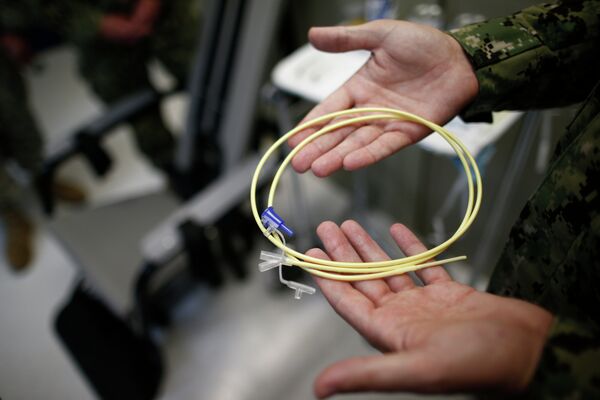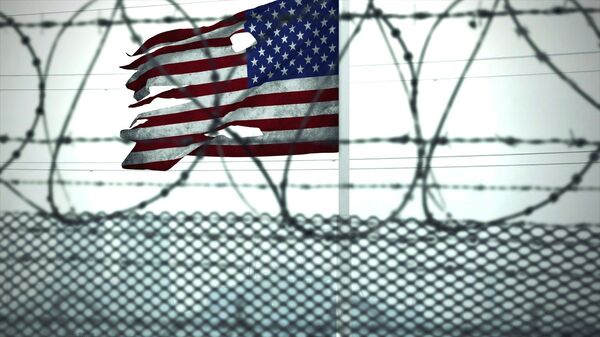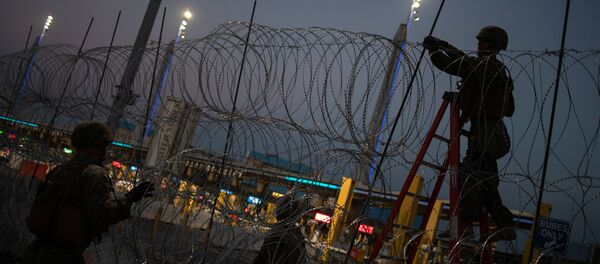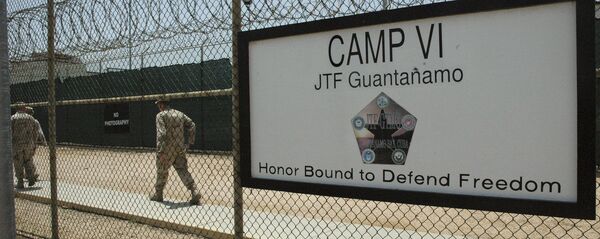Detainees at several ICE processing centers have been refusing to eat or drink for weeks in protest of their treatment by ICE officials. While awaiting the processing of their applications to enter the US, they are detained in prison-like facilities for long periods of time and have been subjected to what they describe as rampant verbal abuse and threats, including of deportation, by guards.
On Thursday, ICE announced it had begun force-feeding six of the striking detainees, who haven't eaten for weeks. The practice involves restraining them while a tube is shoved up their nose and down their throat and risks injury to the person it's performed on in numerous ways.
Nonprofit advocacy group Freedom for Immigrants has documented 1,396 people on hunger strike in 18 immigration detention facilities since May 2015. Citing detainees, relatives and an attorney, AP concluded there are 30 hunger strikers in ICE facilities right now, while ICE has only confirmed 11, due to differing definitions of what constitutes a hunger strike.
Physicians for Human Rights and the American Medical Association have both declared that "forcible feeding is never ethically acceptable," Gizmodo noted. The World Medical Association and Red Cross have categorized it as "torture and other cruel, inhuman and degrading treatment." The World Medical Association Declaration of Tokyo also states that prisoners who are capable of "rational judgment concerning the consequences of such a voluntary refusal of nourishment… shall not be fed artificially."
That hasn't stopped ICE, though, which isn't exactly known for its luxurious treatment of detainees. The agency, which falls under the jurisdiction of the US Department of Homeland Security, obtained authority from a federal judge in mid-January to force-feed six detainees at its El Paso, Texas, location, AP reported.
"Nine of the 11 detainees missed their ninth consecutive meal, triggering hunger strike protocols, in late December and early January," ICE spokesperson Dani Bennett said in a statement Thursday.
However, while force-feeding is a controversial measure, it doesn't always require a court order, AP noted. Federal courts haven't ruled on the issue, and rules can vary by district and type of court. ICE refused to confirm having engaged in the practice in the past, but Christina Fialho, director of Freedom for Immigrants, told the news service she couldn't recall a situation in which it had happened at an ICE facility.
"Efforts are being taken to protect the detainees' health and privacy," Bennett said.
A Gizmodo article from 2015 describes the process of force-feeding with gruesome precision: first you are given an IV to bring up blood insulin to safer levels, after having them decrease from weeks of not eating. Then you are fed a slew of drugs designed to make it easier for the tube to go into your nose and down your throat, and for the food to go into your stomach and not come back up again, although the publication clarifies that pain, vomiting and bleeding are common despite the drugs.

Attorney Ruby Kaur, who represents one of the hunger strikers, told AP her client was one of those force-fed, saying they had been put on an IV after more than three weeks of striking.
"They go on hunger strike, and they are put into solitary confinement and then the ICE officers kind of psychologically torture them, telling the asylum seekers they will send them back to Punjab," Kaur said.
"They are restraining people and forcing them to get tubes put in their noses," Eiorjys Rodriguez Calderin, a detainee at the facility, told AP. "They put people in solitary, as punishment."
CNN notes the prospect of a feeding tube being shoved up one's nose often defuses hunger strikers and convinces them to eat food. However, for those die-hards who refuse to abandon the cause, the next step can be very dangerous: after being restrained, a small tube is shoved up the nose and down the throat. Gizmodo notes that if the tube goes down the windpipe instead of the esophagus — a very real danger — forcing food into someone's lungs can cause pneumonia, a collapsed lung, and even death. X-rays are supposed to prevent this, but there are no guarantees.
Feeding can take hours, and if vomiting follows, it can lead to you being restrained even while digesting the food afterward, the publication notes. Plus, the drugs used to smooth the procedure can themselves have harmful side effects that leave a lasting mark on one's health.
"They're inserting the needles, the fresh needle, every time they put on the glucose on, the drip on. Now, it's beginning to hurt them, they're changing the needle that they insert them," Amrit Singh, uncle of two of the strikers, told CNN, noting that it happens around five or six times per day.
"By starving themselves," Fialho said, "these men are trying to make public the very suffering that ICE is trying keep hidden from taxpayers."





